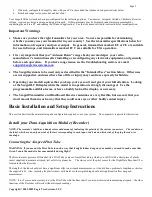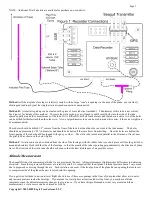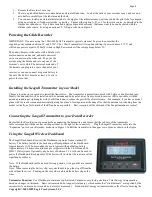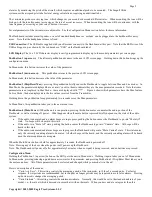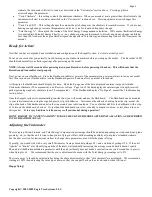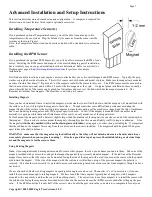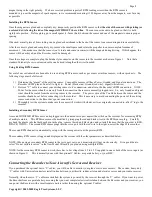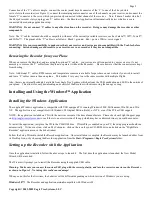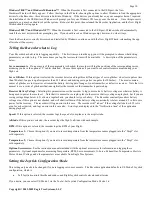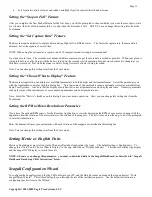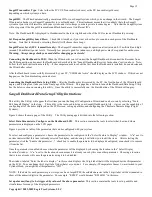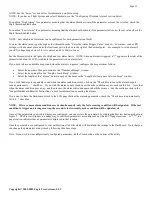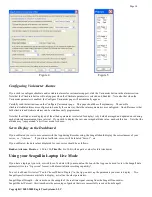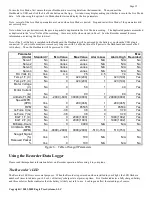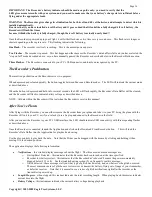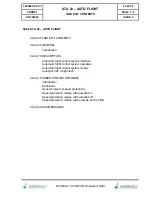
Copyright © 2003-2005 Eagle Tree Systems, LLC
Page 4
1.
Remove the Recorder’s case top.
2.
There is a predrilled hole to accommodate an external altitude tube. Look at the back of your recorder cover, and use an x-
acto knife to carefully cut the label around the hole.
3.
You can now install an external altimeter tube to the nipple of the altimeter sensor just like you do the pitot tube for airspeed,
using an extra piece of rubber pitot tube, or similar. Choose either option A, B, or C for the static source, as described in the
Airspeed section above. If you have installed a static airspeed tube already, that same static tube can be shared with the
altitude static source, by using an optional ‘T’ fitting, as shown in Figure 1.
Powering the Glide Recorder
IMPORTANT: If you are using the 1 Watt 900 MHz Transmitter, special care must be given to ensure that the
supplied power remains between 5V and 5.75V. The 1 Watt Transmitter will stop transmitting if powered above 5.75V, and
will reduce power output to 500 mW (when in High Power mode) if the voltage drops below 5V.
The battery harness is the cable with a Futaba style
male connector on one end, and male universal
servo connector on the other end. To power the
system, plug the Futaba end into any one of the
recorder’s servo slots. The universal male end of
the harness can plug into a spare channel of your
receiver, or you can connect a separate battery to
the unit. The battery must be at least 4.5 volts to
power the recorder.
Installing the Seagull Transmitter in your Model
Choose a location in your model to install the transmitter. The transmitter is normally mounted with Velcro or double sided tape.
Ideally, the transmitter will be installed with its antenna and body as far away from your radio receiver (RX) as possible, with the
antenna protruding at right angles with your RX antenna, to reduce the possibility of interference. For example, if you have a model
plane with the receiver mounted horizontally along the plane’s fuselage, mount the Seagull so that the antenna is protruding from the
model vertically, as far forward of the RX antenna as possible. Best reception will be obtained if the Seagull antenna is vertical.
Connecting the Seagull Transmitter to your Data Recorder
Ensure that the Recorder is not powered when connecting the transmitter, and ensure that the red wire of the transmitter
cable corresponds with the red dot on the port label (to the right of the connector). Plug the Seagull Transmitter cable into the
“Expansion” port on your Recorder, as shown in Figure 1. Install the transmitter in the upper row of pins, as shown in the figure.
Using the Seagull Wireless Dashboard
The Seagull Dashboard Receiver (the Dashboard) operates from a standard 9V
battery. The battery installs in the back snap-off compartment of the Dashboard.
Approximately 12-14 hours continuous use is typical with an alkaline battery.
Approximately 3-4 hours of continuous use is typical with the 2.4 GHz and 900
MHz/1 Watt systems. Optionally, any battery of between 5-16 volts can be used to
power the Dashboard. Rechargeable 9V batteries will work, but the run time will be
significantly reduced..
Note: If the Dashboard will be unused for long periods, it is a good idea to remove
the battery.
Note: When removing the battery clip, use your thumb to pop the clip off from the
side without the wires. Pushing on the wire side can break the battery clip or the
wires.
Variometer Function:
Your Dashboard contains a sophisticated Variometer, employing electronic Total Energy Compensation,
based on changes in Airspeed. Basic variometers do not support total energy, which means that “stick thermals” are reported by the
variometer if you descend or ascend due to elevator movement. Standard total energy variometers reduce the effects of moving the


